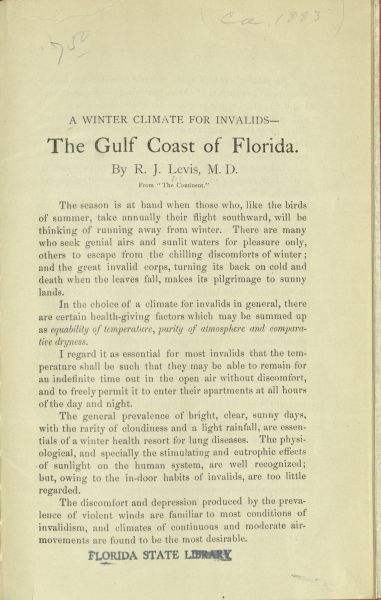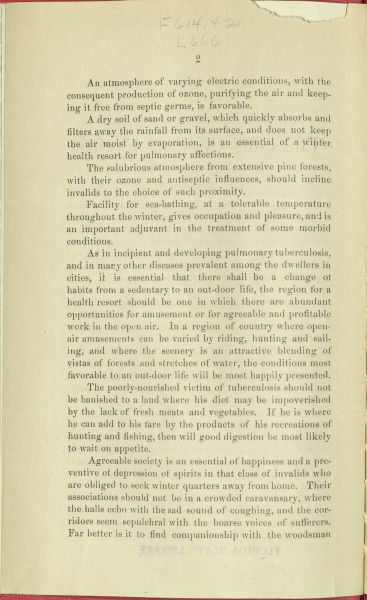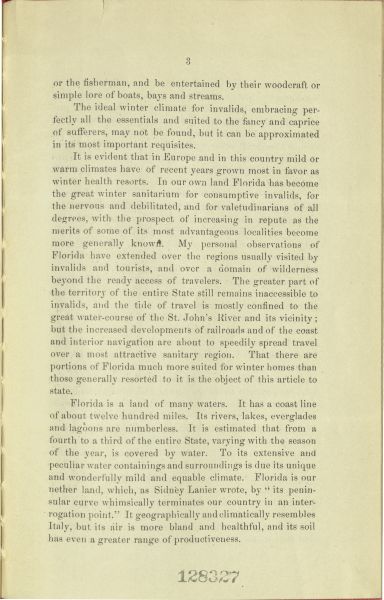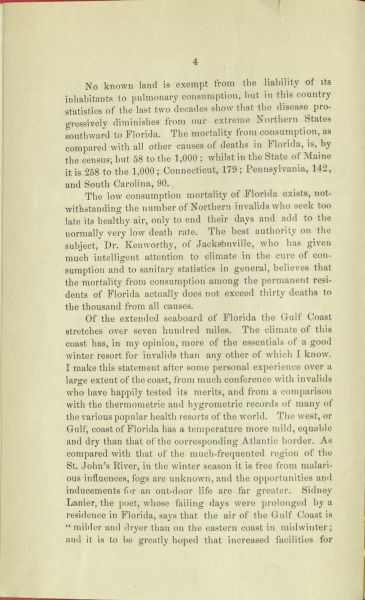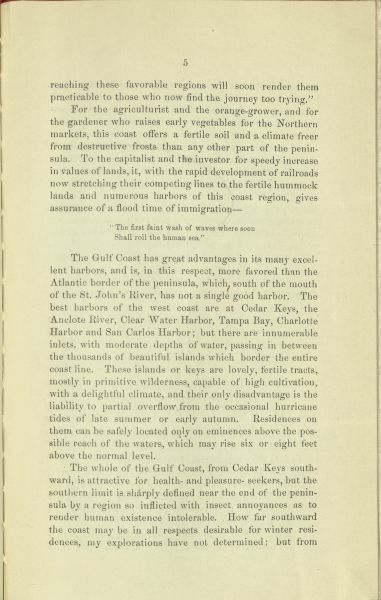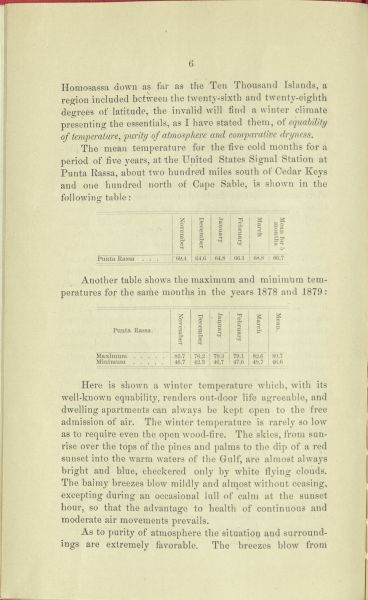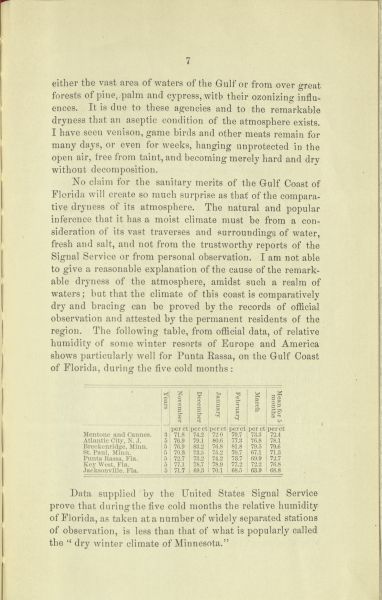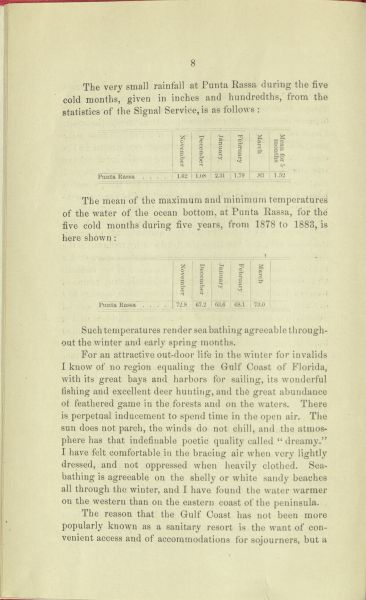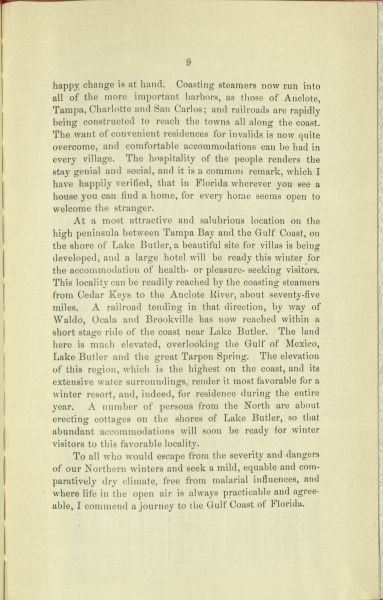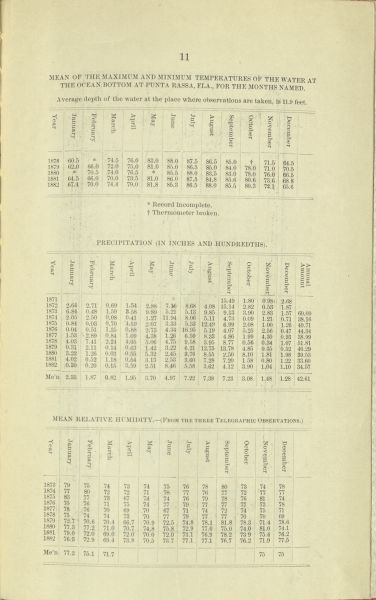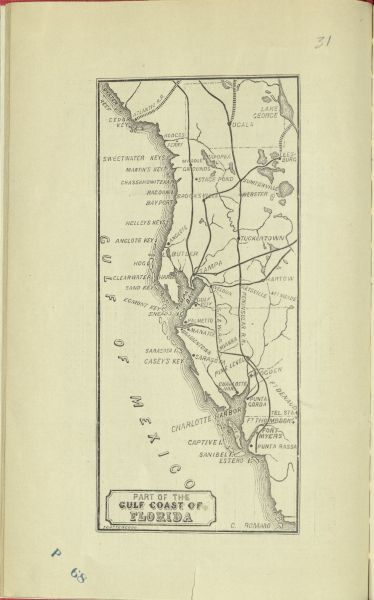Florida Memory is administered by the Florida Department of State, Division of Library and Information Services, Bureau of Archives and Records Management. The digitized records on Florida Memory come from the collections of the State Archives of Florida and the special collections of the State Library of Florida.

State Archives of Florida
- ArchivesFlorida.com
- State Archives Online Catalog
- ArchivesFlorida.com
- ArchivesFlorida.com
State Library of Florida
Related Sites
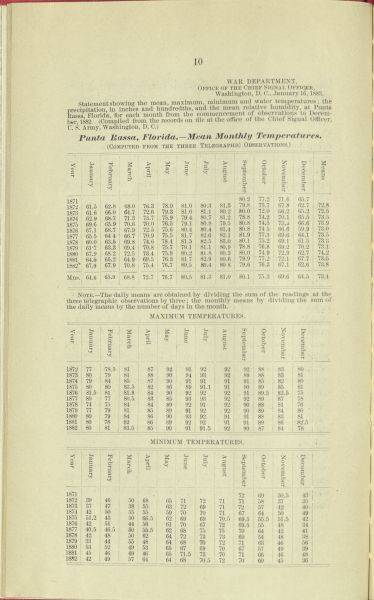
Description of previous item
Description of next item

Article titled "The Gulf Coast of Florida: A Winter Climate for Invalids," ca. 1883
Source
Description
Date
Format
Topic
Geographic Term
Punta Rassa, Florida. - Mean Monthly Temperatures [in degrees Fahrenheit].
(Computed from the three telegraphic observations.)
| January | February | March | April | May | June | July | August | September | October | November | December | Means | |
|---|---|---|---|---|---|---|---|---|---|---|---|---|---|
| 1871 | 80.2 | 77.2 | 71.6 | 65.7 | |||||||||
| 1872 | 61.5 | 62.8 | 68.0 | 76.3 | 78.0 | 81.0 | 80.3 | 81.3 | 79.8 | 73.7 | 67.8 | 62.7 | 72.8 |
| 1873 | 61.6 | 66.0 | 64.7 | 72.6 | 79.3 | 81.0 | 81.1 | 80.2 | 80.0 | 72.0 | 66.2 | 65.2 | 72.5 |
| 1874 | 62.9 | 68.7 | 71.3 | 73.7 | 75.9 | 79.4 | 80.7 | 81.2 | 78.8 | 74.2 | 70.1 | 65.5 | 73.5 |
| 1875 | 69.6 | 65.9 | 70.6 | 70.9 | 76.5 | 79.1 | 80.9 | 79.5 | 80.8 | 74.5 | 73.5 | 66.6 | 73.9 |
| 1876 | 67.1 | 68.7 | 67.9 | 72.5 | 75.6 | 80.4 | 80.4 | 81.4 | 80.8 | 745 | 66.6 | 59.9 | 73.0 |
| 1877 | 65.5 | 64.4 | 66.7 | 70.9 | 75.5 | 81.7 | 82.6 | 82.1 | 81.9 | 77.3 | 60.6 | 64.1 | 73.5 |
| 1878 | 60.0 | 63.5 | 69.8 | 74.6 | 78.4 | 81.5 | 82.5 | 83.8 | 80.1 | 73.2 | 69.1 | 61.5 | 73.5 |
| 1879 | 61.7 | 63.8 | 69.4 | 70.8 | 75.7 | 79.1 | 81.1 | 80.9 | 78.8 | 76.8 | 69.2 | 70.2 | 73.1 |
| 1880 | 67.9 | 68:2 | 72.5 | 73.4 | 75.8 | 80.2 | 81.8 | 80.3 | 80.0 | 74.9 | 72.9 | 62.7 | 74.2 |
| 1881 | 64.5 | 65.2 | 64.9 | 69.5 | 76.3 | 81.7 | 82.9 | 80.6 | 79.9 | 77.2 | 72.1 | 67.7 | 73.0 |
| 1882 | 67.9 | 67.9 | 70.8 | 75.4 | 76.7 | 80.5 | 80.4 | 80.8 | 79.6 | 76.3 | 67.1 | 62.6 | 73.8 |
| Mns. | 64.6 | 65.9 | 68.8 | 72.7 | 76.7 | 80.5 | 81.3 | 81.0 | 80.1 | 75.3 | 69.6 | 64.5 | 73.4 |
MAXIMUM TEMPERATURES [in degrees Fahrenheit]
| Year | January | February | March | April | May | June | July | August | September | October | November | December |
|---|---|---|---|---|---|---|---|---|---|---|---|---|
| 1872 | 77 | 78.5 | 81 | 87 | 92 | 91 | 92 | 92 | 92 | 88 | 83 | 80 |
| 1873 | 80 | 79 | 81 | 88 | 90 | 94 | 93 | 92 | 89 | 88 | 83 | 81 |
| 1874 | 79 | 84 | 85 | 87 | 90 | 91 | 91 | 91 | 91 | 85 | 82 | 80 |
| 1875 | 80 | 80 | 83.5 | 82 | 86 | 89 | 91.1 | 91 | 90 | 89 | 85 | 81 |
| 1876 | 81.5 | 81 | 81.8 | 84 | 90 | 952 | 92 | 92 | 91 | 89.5 | 82.5 | 75 |
| 1877 | 80 | 77 | 80.5 | 83 | 85 | 93 | 93 | 92 | 92 | 89 | 87 | 78 |
| 1878 | 74 | 75 | 84 | 84 | 89 | 92 | 91 | 92 | 90 | 88 | 81 | 76 |
| 1879 | 77 | 79 | 81 | 85 | 89 | 91 | 92 | 92 | 90 | 89 | 84 | 80 |
| 1880 | 80 | 79 | 84 | 86 | 90 | 93 | 92 | 91 | 91 | 88 | 83 | 81 |
| 1881 | 80 | 78 | 82 | 86 | 89 | 92 | 92 | 91 | 91 | 89 | 86 | 82.5 |
| 1882 | 80 | 81 | 83.5 | 85 | 90 | 91 | 91.5 | 92 | 90 | 87 | 84 | 78 |
MINIMUM TEMPERATURE [in degrees Fahrenheit]
| Year | January | February | March | April | May | June | July | August | September | October | November | December |
|---|---|---|---|---|---|---|---|---|---|---|---|---|
| 1871 | 72 | 69 | 50.5 |
43 |
||||||||
| 1872 | 39 | 46 | 50 | 68 | 65 | 71 | 72 | 71 | 71 | 58 | 37 | 35 |
| 1873 | 37 | 47 | 38 | 55 | 63 | 81 | 69 | 71 | 72 | 57 | 42 |
40 |
| 1874 | 42 | 50 | 55 | 55 | 59 | 70 | 70 | 71 | 67 | 64 | 50 | 49 |
| 1875 | 51.2 | 43 | 50 | 66.5 | 62 | 69 | 69 | 70.5 | 69.5 | 55.5 | 51.5 |
42 |
| 1876 | 42 | 51 | 44 | 56 | 61 | 70 | 67 | 72 | 69.5 | 55 | 48 | 34 |
| 1877 | 40.5 | 46.5 | 50 | 55.5 | 62 | 68 | 75 | 75 | 70 | 64 | 42 | 41 |
| 1878 | 42 | 48 | 50 | 62 | 64 | 72 | 73 | 73 | 69 | 54 | 48 | 38 |
| 1879 | 33 | 44 | 55 | 48 | 64 | 68 | 70 | 72 | 71 | 63 | 46 | 56 |
| 1880 | 53 | 52 | 49 | 53 | 65 | 67 | 69 | 70 | 67 | 57 | 49 | 39 |
| 1881 | 45 | 46 | 49 | 46 | 64 | 71.5 | 73 | 70 | 71 | 66 | 46 | 48 |
| 1882 | 42 | 49 | 57 | 64 | 64 | 6 | 70.5 | 72 | 70 | 60 | 45 | 36 |
Title
Subject
Description
Creator
Source
Date
Format
Language
Type
Identifier
Coverage
Geographic Term
Thumbnail
ImageID
topic
Transcript
An atmosphere of varying electric conditions, with the Consequent production of ozone, purifying the air and keeping it free from septic germs, is favorable.
A dry soil of sand or gravel, which quickly absorbs and Filters away the rainfall from its surface, and does not keep The air moist by evaporation, is an essential of a winter health resort for pulmonary affections.
The salubrious atmosphere from extensive pine forests, with their ozone and antiseptic influences, should incline invalids to the choice of such proximity.
Facility for sea-bathing, at a tolerable temperature throughout the winter, gives occupation and pleasure, and is an important adjuvant in the treatment of some morbid conditions.
As in incipient and developing pulmonary tuberculosis and in many other diseases prevalent among the dwellers in cities, it is essential that there shall be a change of habits from a sedentary to an out-door life, the region for a health resort should be one in which there are abundant opportunities for amusement or for agreeable and profitable work in the open air. In a region of country where open-air amusements can be varied by riding, hunting and sailing, and where the scenery is an attractive blending of vistas of forests and stretches of water, the conditions most favorable to an out-door life will be most happily presented.
The poorly-nourished victim of tuberculosis should not be banished to a land where his diet may be impoverished by the lack of fresh meats and vegetables. If he is where he can add to his fare by the products of his recreations of hunting and fishing, then will good digestion be most likely to wait on appetite.
Agreeable society is an essential of happiness and a preventive of depression of spirits in the class of invalids who are obliged to seek winter quarters away from home. Their associations should not be in a crowded caravansary, where the halls echo with sad sound of coughing, and the corridors seem sepulchral with the hoarse voices of sufferers. Far better is it to find companionship with the woodsman
or the fisherman, and be entertained by their woodcraft or simple lore of boats, bays and streams.
The ideal winter climate for invalids, embracing perfectly all the essentials and suited to the fancy and caprice of sufferers, may not be found, but it can be approximated in its most important requisites.
It is evident that in Europe and in this country mild or warm climates have of recent years grown most in favor as winter health resorts. In our own land Florida has become the great winter sanitarium for consumptive invalids, for the nervous and debilitated, and for valetudinarians of all degrees, with the prospect of increasing in repute as the merits of some of its most advantageous localities become more generally known. My personal observations of Florida have extended over the regions usually visited by invalids and tourists, and over a domain of wilderness beyond the ready access of travelers. The greater part of the territory of the entire State still remains inaccessible to invalids, and the tide of travel is mostly confined to the great water-course of the St. John's River and its vicinity; but the increased developments of railroads and of the coast and interior navigation are about to speedily spread travel over a most attractive sanitary region. That there are portions of Florida much more suited for winter homes than those generally resorted to it is the object of this article to state.
Florida is a land of many waters. It has a coast line of about twelve hundred miles. Its rivers, lakes, everglades and lagoons are numberless. It is estimated that from a fourth to a third of the entire State, varying with the season of the year, is covered by water. To its extensive and peculiar water containing and surroundings is due to its unique and wonderfully mild and equable climate. Florida is our nether land, which, as Sidney Lanier wrote, by "its peninsular curve whimsically terminates our country in an interrogation point." It geographically and climatically resembles Italy, but its air is more bland and healthful, and its soil Has even a greater range of productiveness.
No known land is exempt from the liability of its inhabitants to pulmonary consumption, but in this country statistics of the last two decades show that the disease progressively diminishes from our extreme Northern States southward to Florida. The mortality from consumption, as compared with all other causes of deaths in Florida, is, by the census, but 58 to the 1,000; whilst in the State of Maine it is 258 to the 1,000; Connecticut, 179; Pennsylvania, 142, and South Carolina, 90.
The low consumption mortality of Florida exists, notwithstanding the number of Northern invalids who seek too late its healthy air, only to end their days and add to the normally very low death rate. The best authority on the subject, Dr. Kenworthy, of Jacksonville, who has given much intelligent attention to climate in the cure of consumption and to sanitary statistics in general, believes that the mortality from consumption among the permanent residents of Florida actually does not exceed thirty deaths to the thousand from all causes.
Of the extended seaboard of Florida the Gulf Coast stretches over seven hundred miles. The climate of this coast has, in my opinion, more of the essentials of a good winter resort for invalids tan any other of which I know. I make this statement after some personal experience over a large extent of the coast, from much conference with invalids who have happily tested its merits, and from a comparison with the thermometric and hygrometric records of many of the various popular health resorts of the world. The west, or Gulf, coast of Florida has a temperature more mild, equable and dry than that of the corresponding Atlantic border. As compared with that of the much-frequented region of the St. John's River, in the winter season it is free from malarious influences, fogs are unknown, and the opportunities and inducements for an out-door life are far greater. Sidney Lanier, the poet, whose failing days were prolonged by a residence in Florida, says that the air of the Gulf Coast is "milder and dryer than on the eastern coast in midwinter; and it is to be greatly hoped that increase facilities for
reaching these favorable regions will soon render them practicable to those who now find the journey too trying."
For the agriculturist and the orange-grower, and for the gardener who raises early vegetables for the Northern markets, this coast offers a fertile soil and a climate freer from destructive frosts than any other part of the peninsula. To the capitalist and the investor for speedy increase in values of lands, it, with the rapid development of railroads now stretching their competing lines to the fertile hummock lands and numerous harbors of this coast region, gives assurance of a flood times of immigration
"The first faint wash of waves where soon
Shall roll the human sea."
The Gulf Coast has great advantages in its many excellent harbors, and is, in this respect, more favored than the Atlantic border of the peninsula, which south of the mouth of the St. John's River, has not a single good harbor. The best harbors of the west coast are at Cedar Keys, the Anclote River, Clear Water Harbor, Tampa Bay, Charlotte Harbor and San Carlos Harbor; but there are innumerable inlets, with moderate depths of water, passing in between the thousands of beautiful islands which border the entire coast line. These islands or keys are lovely, fertile tracts, mostly in primitive wilderness, capable of high cultivation, with a delightful climate, and their only disadvantage is the liability to partial overflow from the occasional hurricane tides of late summer or early autumn. Residences on them can be safely located only on eminences above the possible reach of the waters, which may rise six or eight feet above the normal level.
The whole of the Gulf Coast, from Cedar Keys southward, is attentive for health- and pleasure-seekers, but the southern limit is sharply defined near the end of the peninsula by a region so inflicted with insect annoyances as to render human existence intolerable. How far southward the coast may be in all respects desirable for winter residences, my explanations have not determined; but from
Homosassa down as far as the Ten Thousand Islands, a region included between the twenty-sixth and twenty-eight degrees of latitude, the invalid will find a winter climate presenting the essentials, as I have stated them, of equability of temperature, purity of atmosphere and comparative dryness.
The mean temperature for the five cold months for a Period of five years, at the United States Signal Station at Punta Rassa, about two hundred miles south of Cedar Keys and one hundred north of Cape Sable, is shown in the following table:
| November | December | January | February | March | Mean for 5 months | |
|---|---|---|---|---|---|---|
| Punta Rassa | 69.4 [degrees Fahrenheit] | 64.6 [degrees Fahrenheit] | 64.8 [degrees Fahrenheit] | 66.1 [degrees Fahrenheit] | 68.8 [degrees Fahrenheit] | 66.7 [degrees Fahrenheit] |
Another table shows the maximum and minimum temperatures for the same months in the years 1878 and 1879:
| Punta Rassa. | November | December | January | February | March | Mean. |
|---|---|---|---|---|---|---|
| Maximum [degrees Fahrenheit] | 83.7 | 76.2 | 79.3 | 79.1 | 82.6 | 80.7 |
| Minimum [degrees Fahrenheit] | 46.7 | 42.3 | 46.7 | 47.6 | 49.7 | 46.6 |
Here is shown a winter temperature which, with its well-known equability, renders out-door life agreeable, and dwelling apartments can always be kept open to the free admission of air. The winter temperature is rarely so low as to require even the open wood-fire. The skies, from sunrise to ver the tops of the pines and palms to the dip of a red sunset into the warm waters of the Gulf, are almost always bright and blue, checkered only by white flying clouds. The balmy breezes blow mildly and almost without ceasing, excepting during an occasional lull of calm at the sunset hour, so that the advantage to health of continuous and moderate air movement prevails. As to purity of atmosphere the situation and surroundings are extremely favorable. The breezes blow from
No claim for the sanitary merits of the Gulf Coast of Florida will create so much surprise as that of the comparative dryness of its atmosphere. The natural and popular inference that it has a moist climate must be from a consideration of its vast traverses and surroundings of water, fresh and salt, and not from the trustworthy reports of the Signal Service or from personal observation. I am not able to give a reasonable explanation of the cause of the remarkable dryness of the atmosphere, admist such a realm of waters; but that the climate of this coast is comparatively dry and bracing can be proved by the records of official observation and attested by the permanent residents of the region. The following table, from official data, of relative humidity of some winter resorts of Europe and America shows particularly well for Punta Rassa, on the Gulf Coast of Florida, during the five cold months:
| Years | November | December | January | February | March | Mean for 5 months | |
|---|---|---|---|---|---|---|---|
| [% realtive humidity] | [% realtive humidity] | [% realtive humidity] | [% realtive humidity] | [% realtive humidity] | [% realtive humidity] | ||
| Mentone and Cannes. | 3 | 71.8 | 74.2 | 72.0 | 70.7 | 73.3 | 72.4 |
| Atlantic City, N.J. | 5 | 76.9 | 79.1 | 80.6 | 77.3 | 76.8 | 78.1 |
| Breckenridge, Minn. | 5 | 76.9 | 83.2 | 76.8 | 81.8 | 79.5 | 79.6 |
| St. Paul, Minn. | 5 | 70.3 | 73.5 | 75.2 | 70.7 | 67.1 | 71.3 |
| Punta Rassa, Fla. | 5 | 72.7 | 73.2 | 74.2 | 73.7 | 69.9 | 72.7 |
| Kew West, Fla. | 5 | 77.1 | 78.7 | 78.9 | 77.2 | 72.2 | 76.8 |
| Jacksonville, Fla. | 5 | 71.7 | 69.3 | 70.1 | 68.5 | 63.9 | 68.8 |
Data supplied by the United States Signal Service prove that during the five cold months the relative humidity of Florida, as taken at a number of widely spirited stations of observation, is less than that of what is popularly called the "dry winter climate of Minnesota."
| November | December | January | February | March | Mean for 5 months | |
|---|---|---|---|---|---|---|
| Punta Rassa | 1.61 [inches] | 1.08 [inches] | 2.31 [inches] | 1.79 [inches] | .83 [inches] | 1.52 [inches] |
The mean of the maximum and minimum temperatures of the water of the ocean bottom, at Punta Rassa, for the five cold months during five years, from 1878 to 1883, is here shown:
| November | December | January | February | March | Mean for 5 months | |
|---|---|---|---|---|---|---|
| Punta Rassa | 72.8 [degrees Fahrenheit] | 67.2 [degrees Fahrenheit] | 63.6 [degrees Fahrenheit] | 68.1 [degrees Fahrenheit] | 73.0 [degrees Fahrenheit] | 1.52 [inches] |
Such temperatures render sea bathing agreeable throughout the winter and early spring months.
For an attractive out-door life in the winter for invalids I know of no region equaling the Gulf Coast of Florida, with its great bays and harbors for sailing, its wonderful fishing and excellent deer hunting, and for the great abundance of feathered game in the forest and on the waters. There is perpetual inducement to spend time in the open air. The sun does not parch, the winds do not chill, and the atmosphere has that indefinable poetic quality called "dreamy." I have felt comfortable in the bracing air when very lightly dressed, and not oppressed when heavily clothed. Seabathing is agreeable on the shelly or white sandy beaches all through the winter. And I have found the water warmer on the western than on the eastern coast of the peninsula.
The reason that the Gulf Coast has not been more popularly known as the sanitary resort is the want of convenient access and of accommodations for sojourners, but a
Happy change is at hand. Coasting steamers now run into All of the more important harbors, as those of Anclote, Tampa, Charlotte, and San Carlos; and railroads are rapidly being constructed to reach the towns all along the coast. The want of convenient residences for invalids is now quite Overcome, and comfortable accommodations can be had in every village. The hospitality of the people renders the stay genial and social, and it is a common remark, which I have happily verified, that in Florida wherever you see a house you can find a home, for every home seems open to welcome the stranger.
At a most attractive and salubrious location on the high peninsula between Tampa Bay and the Gulf Coast, on the shore of Lake Butler, a beautiful site for villas is being developed, and a large hotel will be ready this winter for the accommodation of health- or pleasure- seeking visitors. This locality can be readily reached by the coasting steamers from Cedar Keys to the Anclote River, about seventy-five miles. A railroad tending in that direction, by way of Waldo, Ocala and Brookville has now reached within a short stage ride of the coast near Lake Butler. The land here is much elevated, overlooking the Gulf of Mexico, Lake Butler and the great Tarpon Spring. The elevation of this region, which is the highest on the coast, and its extensive water surrounding, render it most favorable for a winter resort, and indeed, for residence during t he entire year. A number of persons from the North are about erecting cottages on the shores of Lake Butler, so that abundant accommodations will soon be ready for winter visitors to this favorable locality.
To all who would escape from the severity and dangers of our Northern winters and seek a mild, equable and comparatively dry climate, free from malarial influences, and where life in the open air is always practicable and agreeable, I commend a journey to the Gulf Coast of Florida.
Punta Rassa, Florida. - Mean Monthly Temperatures [in degrees Fahrenheit].
(Computed from the three telegraphic observations.)
| January | February | March | April | May | June | July | August | September | October | November | December | Means | |
|---|---|---|---|---|---|---|---|---|---|---|---|---|---|
| 1871 | 80.2 | 77.2 | 71.6 | 65.7 | |||||||||
| 1872 | 61.5 | 62.8 | 68.0 | 76.3 | 78.0 | 81.0 | 80.3 | 81.3 | 79.8 | 73.7 | 67.8 | 62.7 | 72.8 |
| 1873 | 61.6 | 66.0 | 64.7 | 72.6 | 79.3 | 81.0 | 81.1 | 80.2 | 80.0 | 72.0 | 66.2 | 65.2 | 72.5 |
| 1874 | 62.9 | 68.7 | 71.3 | 73.7 | 75.9 | 79.4 | 80.7 | 81.2 | 78.8 | 74.2 | 70.1 | 65.5 | 73.5 |
| 1875 | 69.6 | 65.9 | 70.6 | 70.9 | 76.5 | 79.1 | 80.9 | 79.5 | 80.8 | 74.5 | 73.5 | 66.6 | 73.9 |
| 1876 | 67.1 | 68.7 | 67.9 | 72.5 | 75.6 | 80.4 | 80.4 | 81.4 | 80.8 | 745 | 66.6 | 59.9 | 73.0 |
| 1877 | 65.5 | 64.4 | 66.7 | 70.9 | 75.5 | 81.7 | 82.6 | 82.1 | 81.9 | 77.3 | 60.6 | 64.1 | 73.5 |
| 1878 | 60.0 | 63.5 | 69.8 | 74.6 | 78.4 | 81.5 | 82.5 | 83.8 | 80.1 | 73.2 | 69.1 | 61.5 | 73.5 |
| 1879 | 61.7 | 63.8 | 69.4 | 70.8 | 75.7 | 79.1 | 81.1 | 80.9 | 78.8 | 76.8 | 69.2 | 70.2 | 73.1 |
| 1880 | 67.9 | 68:2 | 72.5 | 73.4 | 75.8 | 80.2 | 81.8 | 80.3 | 80.0 | 74.9 | 72.9 | 62.7 | 74.2 |
| 1881 | 64.5 | 65.2 | 64.9 | 69.5 | 76.3 | 81.7 | 82.9 | 80.6 | 79.9 | 77.2 | 72.1 | 67.7 | 73.0 |
| 1882 | 67.9 | 67.9 | 70.8 | 75.4 | 76.7 | 80.5 | 80.4 | 80.8 | 79.6 | 76.3 | 67.1 | 62.6 | 73.8 |
| Mns. | 64.6 | 65.9 | 68.8 | 72.7 | 76.7 | 80.5 | 81.3 | 81.0 | 80.1 | 75.3 | 69.6 | 64.5 | 73.4 |
MAXIMUM TEMPERATURES [in degrees Fahrenheit]
| Year | January | February | March | April | May | June | July | August | September | October | November | December |
|---|---|---|---|---|---|---|---|---|---|---|---|---|
| 1872 | 77 | 78.5 | 81 | 87 | 92 | 91 | 92 | 92 | 92 | 88 | 83 | 80 |
| 1873 | 80 | 79 | 81 | 88 | 90 | 94 | 93 | 92 | 89 | 88 | 83 | 81 |
| 1874 | 79 | 84 | 85 | 87 | 90 | 91 | 91 | 91 | 91 | 85 | 82 | 80 |
| 1875 | 80 | 80 | 83.5 | 82 | 86 | 89 | 91.1 | 91 | 90 | 89 | 85 | 81 |
| 1876 | 81.5 | 81 | 81.8 | 84 | 90 | 952 | 92 | 92 | 91 | 89.5 | 82.5 | 75 |
| 1877 | 80 | 77 | 80.5 | 83 | 85 | 93 | 93 | 92 | 92 | 89 | 87 | 78 |
| 1878 | 74 | 75 | 84 | 84 | 89 | 92 | 91 | 92 | 90 | 88 | 81 | 76 |
| 1879 | 77 | 79 | 81 | 85 | 89 | 91 | 92 | 92 | 90 | 89 | 84 | 80 |
| 1880 | 80 | 79 | 84 | 86 | 90 | 93 | 92 | 91 | 91 | 88 | 83 | 81 |
| 1881 | 80 | 78 | 82 | 86 | 89 | 92 | 92 | 91 | 91 | 89 | 86 | 82.5 |
| 1882 | 80 | 81 | 83.5 | 85 | 90 | 91 | 91.5 | 92 | 90 | 87 | 84 | 78 |
MINIMUM TEMPERATURE [in degrees Fahrenheit]
| Year | January | February | March | April | May | June | July | August | September | October | November | December |
|---|---|---|---|---|---|---|---|---|---|---|---|---|
| 1871 | 72 | 69 | 50.5 |
43 |
||||||||
| 1872 | 39 | 46 | 50 | 68 | 65 | 71 | 72 | 71 | 71 | 58 | 37 | 35 |
| 1873 | 37 | 47 | 38 | 55 | 63 | 81 | 69 | 71 | 72 | 57 | 42 |
40 |
| 1874 | 42 | 50 | 55 | 55 | 59 | 70 | 70 | 71 | 67 | 64 | 50 | 49 |
| 1875 | 51.2 | 43 | 50 | 66.5 | 62 | 69 | 69 | 70.5 | 69.5 | 55.5 | 51.5 |
42 |
| 1876 | 42 | 51 | 44 | 56 | 61 | 70 | 67 | 72 | 69.5 | 55 | 48 | 34 |
| 1877 | 40.5 | 46.5 | 50 | 55.5 | 62 | 68 | 75 | 75 | 70 | 64 | 42 | 41 |
| 1878 | 42 | 48 | 50 | 62 | 64 | 72 | 73 | 73 | 69 | 54 | 48 | 38 |
| 1879 | 33 | 44 | 55 | 48 | 64 | 68 | 70 | 72 | 71 | 63 | 46 | 56 |
| 1880 | 53 | 52 | 49 | 53 | 65 | 67 | 69 | 70 | 67 | 57 | 49 | 39 |
| 1881 | 45 | 46 | 49 | 46 | 64 | 71.5 | 73 | 70 | 71 | 66 | 46 | 48 |
| 1882 | 42 | 49 | 57 | 64 | 64 | 6 | 70.5 | 72 | 70 | 60 | 45 | 36 |
| Year | January | February | March | April | May | June | July | August | September | October | November | December |
|---|---|---|---|---|---|---|---|---|---|---|---|---|
| 1878 | 60.5 | * | 74.5 | 76.0 | 83.0 | 88.0 | 87.5 | 86.5 | 85.0 | † | 71.5 | 64.5 |
| 1879 | 62.0 | 66.0 | 72.0 | 75.0 | 81.0 | 85.0 | 86.5 | 85.0 | 84.0 | 78.0 | 71.0 | 70.5 |
| 1880 | * | 70.5 | 74.0 | 76.5 | * | 85.5 | 88.0 | 83.5 | 83.0 | 78.0 | 76.0 | 66.5 |
| 1881 | 64.5 | 66.0 | 70.0 | 73.5 | 81.0 | 86.0 | 87.5 | 84.8 | 85.6 | 80.6 | 73.6 | 68.8 |
| 1882 | 67.4 | 70.0 | 74.4 | 79.0 | 81.8 | 85.3 | 86.5 | 88.0 | 85.5 | 80.3 | 72.1 | 65.6 |
† Thermometer broken.
PRECIPITATION (IN INCHES AND HUNDREDTHS)
| Year | January | February | March | April | May | June | July | August | September | October | November | December | Annual Ammount |
|---|---|---|---|---|---|---|---|---|---|---|---|---|---|
| 1871 | 15.49 | 1.80 | 0.98 | 2.68 | |||||||||
| 1872 | 2.64 | 2.71 | 0.69 | 1.54 | 2.88 | 7.16 | 8.68 | 4.08 | 15.14 | 2.82 | 0.58 | 1.87 | |
| 1873 | 6.84 | 0.48 | 1.59 | 8.58 | 9.89 | 5.21 | 5.13 | 9.85 | 9.13 | 3.90 | 2.88 | 1.57 | 60.00 |
| 1874 | 2.05 | 2.50 | 0.08 | 0.41 | 1.27 | 11.94 | 8.06 | 5.11 | 4.73 | 0.09 | 1.21 | 0.71 | 38.16 |
| 1875 | 0.84 | 0.08 | 0.70 | 4.59 | 2.07 | 3.33 | 5.33 | 12.49 | 6.99 | 2.08 | 1.00 | 1.26 | 40.71 |
| 1876 | 0.04 | 0.51 | 1.35 | 0.88 | 2.73 | 4.34 | 16.95 | 5.19 | 4.07 | 5.25 | 2.56 | 0.47 | 44.34 |
| 1877 | 1.58 | 2.89 | 0.84 | 1.09 | 4,38 | 1.26 | 6.59 | 8.33 | 4.86 | 1.99 | 4.30 | 0.93 | 38.99 |
| 1878 | 4.03 | 7.41 | 2.24 | 4.05 | 5.06 | 4.75 | 9.58 | 3.95 | 8.77 | 0.56 | 0.84 | 1.07 | 51.81 |
| 1879 | 0.31 | 2.11 | 0.14 | 0.63 | 1.42 | 3.22 | 6.21 | 12.75 | 13.78 | 4.85 | 0.35 | 0.52 | 46.29 |
| 1880 | 3.22 | 1.26 | 0.03 | 0.55 | 5.32 | 2.45 | 8.76 | 8.55 | 2.50 | 8.10 | 1.81 | 1.98 | 39.53 |
| 1881 | 4.02 | 0.52 | 1.18 | 0.54 | 3.13 | 2.53 | 3.60 | 7.28 | 7.20 | 1.58 | 0.80 | 1.22 | 33.60 |
| 1882 | 0.30 | 0.20 | 0.15 | 3.59 | 2.51 | 8.46 | 5.58 | 362 | 4.12 | 3.90 | 1.04 | 1.10 | 34.57 |
| Me’n | 2.35 | 1.87 | 0.42 | 1.95 | 3.70 | 4.97 | 7.22 | 7.88 | 7.23 | 3.08 | 1.48 | 1.28 | 42.6 |
MEAN RELATIVE HUMIDITY. - (From The Three Telegraphic Observations.)
| Year | January | February | March | April | May | June | July | August | September | October | November | December |
|---|---|---|---|---|---|---|---|---|---|---|---|---|
| 1873 | 79 | 75 | 74 | 73 | 74 | 75 | 76 | 78 | 80 | 73 | 74 | 78 |
| 1874 | 77 | 80 | 72 | 72 | 71 | 7 | 77 | 76 | 77 | 72 | 77 |
77 |
| 1875 | 83 | 77 | 73 | 67 | 74 | 74 | 76 | 79 | 78 | 76 | 81 | 74 |
| 1876 | 75 | 76 | 71 | 75 | 74 | 77 | 79 | 77 | 77 | 77 | 73 | 78 |
| 1877 | 78 | 76 | 70 | 69 | 70 | 67 | 71 | 74 | 72 | 74 | 75 | 71 |
| 1878 | 75 | 74 | 74 | 73 | 70 | 77 | 79 | 77 | 77 | 70 | 70 | 69 |
| 1879 | 72.5 | 70.6 | 70.4 | 66.7 | 70.9 | 72.5 | 74.8 | 78.1 | 81.8 | 78.3 | 71.4 | 78.6 |
| 1880 | 77.3 | 77.2 | 71.0 | 70.7 | 74.8 | 75.8 | 72.9 | 77.0 | 75.0 | 74.0 | 81.0 | 74.1 |
| 1881 | 79.0 | 72.0 | 69.0 | 72.0 | 70.0 | 72.0 | 73.1 | 76.9 | 78.2 | 73.9 | 75.4 | 76.2 |
| 1882 | 76.3 | 72.9 | 69.4 | 73.8 | 70.5 | 73.7 | 77.1 | 77.1 | 76.7 | 76.2 | 71.9 | 77.5 |
| Me’n | 77.2 | 75.1 | 71.7 | 75 | 75 |
Chicago Manual of Style
Levis, R. J. (Richard Joseph), 1827-1890. Article titled "The Gulf Coast of Florida: A Winter Climate for Invalids," ca. 1883. 1883 (circa). State Archives of Florida, Florida Memory. <https://www.floridamemory.com/items/show/350918>, accessed 26 November 2025.
MLA
Levis, R. J. (Richard Joseph), 1827-1890. Article titled "The Gulf Coast of Florida: A Winter Climate for Invalids," ca. 1883. 1883 (circa). State Archives of Florida, Florida Memory. Accessed 26 Nov. 2025.<https://www.floridamemory.com/items/show/350918>
AP Style Photo Citation
(State Archives of Florida/Levis)

 Listen: The Latin Program
Listen: The Latin Program